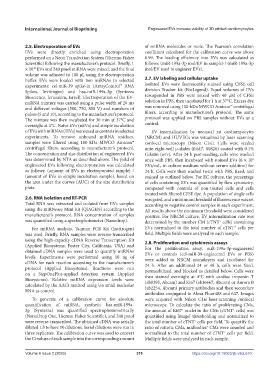Page 327 - IJB-9-2
P. 327
International Journal of Bioprinting Engineered EVs increase viability of 3D printed cardiomyocytes
2.5. Electroporation of EVs of miRNA molecules or mole. The Pearson’s correlation
EVs were directly enriched using electroporation coefficient calculated for the calibration curve was above
performed on a Neon Transfection System (Thermo Fisher 0.99. The loading efficiency into EVs was calculated as
Scientific) following the manufacturer’s protocol. Briefly, 1 follows: (miR-199a-3p mol/EV in sample) / (miR-199a-3p
× 10 EVs and 240 pmol miRNA were mixed, and the final mol/EV used to engineer EVs).
10
volume was adjusted to 100 µL using the electroporation
buffer. EVs were loaded with two miRNAs in selected 2.7. EV labeling and cellular uptake
experiments: cel-miR-39 spike-in (ArrayControl™ RNA Isolated EVs were fluorescently stained using CFSE cell
Spikes, Invitrogen) and hsa-miR-199a-3p (Syntezza division Tracker kit (BioLegend). Equal volumes of EVs
Bioscience, Jerusalem, Israel). Electroporation of the EV- resuspended in PBS were mixed with 40 µM of CFSE
miRNA mixture was carried using a pulse width of 20 ms solution in PBS, then incubated for 1 h at 37°C. Excess dye
and different voltages (500, 750, 850 V) and numbers of was removed using 100-kDa MWCO Amicon™ centrifugal
pulses (5 and 10), according to the manufacturer’s protocol. filters, according to manufacturer’s protocol. The same
The mixture was then incubated for 30 min at 37°C and protocol was applied on PBS samples without EVs as a
overnight at 4°C. Naïve EVs (nEVs) and simple incubation control.
of EVs with miRNAs (iEVs) were used as controls in selected EV internalization by neonatal rat cardiomyocytes
experiments. To remove unbound miRNA residues, (NRCM) and HUVECs was visualized by laser scanning
samples were filtered using 100 kDa MWCO Amicon™ confocal microscopy (Nikon C1si). Cells were seeded
centrifugal filters, according to manufacturer’s protocol. onto eight-well µ-slides (ibidi®, 80826) coated with 0.1%
The concentration and size distribution of engineered EVs Gelatin (w/v). After 24 h post-seeding, cells were washed
was determined by NTA as described above. The yield of once with PBS, then incubated with stained EVs (6 × 10
9
engineered EVs following electroporation was calculated EVs/mL, in culture medium without serum addition) for
as follows: (amount of EVs in electroporated sample) / 24 h. Cells were then washed twice with PBS, fixed, and
(amount of EVs in simple incubation sample), based on stained as outlined below. For EC culture, the percentage
the area under the curves (AUC) of the size distribution of cells containing EVs was quantified by flow cytometry,
plots. compared with controls of non-treated cells and cells
treated with filtered CFSE dye. A population of single cells
2.6. RNA isolation and RT-PCR was gated, and a minimum threshold of fluorescence was set
Total RNA was extracted and isolated from EVs samples according to negative control samples in each experiment.
using the miRNeasy Mini Kit (QIAGEN) according to the All results above the minimum threshold were considered
manufacturer’s protocol. RNA concentration of samples positive. For NRCM culture, EV internalization rate was
was quantified using a spectrophotometer (Nanodrop). determined by the number CM (cTNT cells) containing
+
+
For miRNA analysis, Taqman PCR Kit (Invitrogen) EVs normalized to the total number of cTNT cells per
was used. Briefly, RNA samples were reverse-transcribed field. Multiple fields were analyzed in each sample.
using the high-capacity cDNA Reverse Transcription Kit 2.8. Proliferation and cytokinesis assays
(Applied Biosystems, Foster City, California, USA) and For the proliferation assay, miR-199a-3p-engineered
obtained cDNA samples were used to quantify miRNAs EVs or controls (cel-miR-39-engineered EVs or PBS)
levels. Experiments were performed using 10 ng of were added to NRCM monolayers and incubated for
cDNA for each reaction according to the manufacturer’s 24 h. After an additional 24 or 48 h, cells were fixed,
protocol (Applied Biosystems). Reactions were run permeabilized, and blocked as detailed below. Cells were
on a StepOnePlus‐applied detection system (Applied then stained overnight at 4°C with cardiac troponin T
Biosystems). Relative miRNA expression levels were (ab8295, Abcam) and Ki67 (ab16667, Abcam) or Aurora B
calculated by the ΔΔCt method using U6 small nucleolar (ab2254, Abcam) primary antibodies and then secondary
RNA as control.
antibodies conjugated to Alexa Fluor488 and 647. Images
To generate of a calibration curve for absolute were acquired with Nikon C1si laser-scanning confocal
quantification of miRNA, synthetic hsa-miR-199a- microscope. To calculate the ratio of proliferating CMs,
3p (Syntezza) was quantified spectrophotometrically the amount of Ki67 nuclei in the CMs (cTNT cells) was
+
+
(NanoDrop One, Thermo Fisher Scientific), and 240 pmol quantified using ImageJ thresholding and normalized to
were reverse-transcribed. The obtained cDNA was serially the total number of cTNT cells per field. To quantify the
+
diluted 1:5 to have 10 dilutions. Serial dilutions were run in ratio of mitotic CMs, midbodies CMs were counted and
+
three replicates. The calibration curve was used to convert normalized to the total number of cTNT cells per field.
+
the Ct values of each sample into the corresponding amount Multiple fields were analyzed in each sample.
Volume 9 Issue 2 (2023) 319 https://doi.org/10.18063/ijb.v9i2.670

